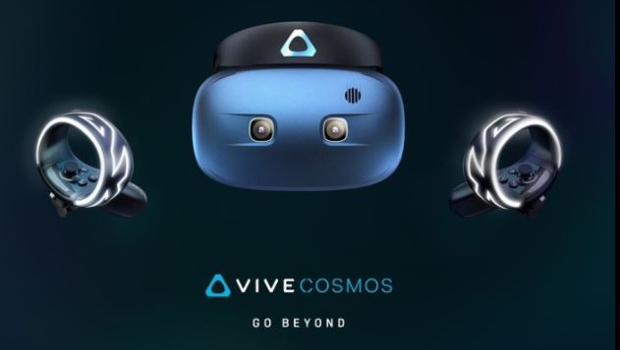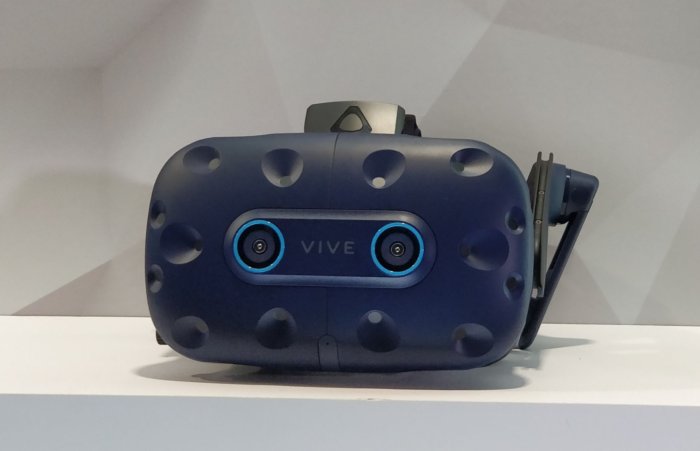
CES 2019: HTC gets real with two new VR headsets
CES, HTC hosted a small press conference that revealed two new pieces of hardware: The Vive Cosmos and Vive Pro Eye. Details on both were skimpy, but perhaps HTC’s finally landed upon a proper Oculus Quest competitor.
Vive Cosmos
The Vive Cosmos is a semi-standalone headset, designed for easy setup and long-term comfort. It is a direct competitor to the Oculus Quest – or the closest we’re going to get from HTC.
That’s probably the most interesting hook for the Vive Cosmos. There weren’t many details during the show, but it sounds as if the Cosmos will be able to hook up to your PC for a high-fidelity experience, or be detached for a more mobile use-case. It doesn’t look like the Cosmos has wires though, which makes you wonder whether the recent HTC Vive wireless adapter – the one using Intel’s WiGig tech – is built straight into the headset this time. That’d perhaps allow for a PC experience as well as a lightweight mobile experience.
In any case, tracking is handled by two cameras on the front of the headset. That’s a step down from the Oculus Quest’s four edge-array cameras. There were also no details on the screen or audio solution. The controllers look similar to the redesigned Vive Focus wands (albeit with Tron-esque light channels around the outside), which isn’t the Oculus Touch competitor people have been hoping for.
Vive Pro Eye
Now the confusing part: HTC announced two standalone headsets at CES. The Vive Cosmos seems like the more consumer-focused of the two, and like it’s being positioned as an Oculus Quest competitor.
The Vive Pro Eye seems more enterprise-focused, even though there’s very little to distinguish it from the Vive Cosmos. Again, we’ve got a standalone headset with dual front-facing cameras, allowing for inside-out position tracking.

The hook with the Vive Pro Eye is the inclusion of eye-tracking – developed in partnershp with Tobii – for Dynamic Foveated Rendering, drastically reducing the performance overhead for VR by rendering areas you aren’t actively looking at in lower fidelity.
It’s strange to see eye-tracking siphoned off to its own Vive headset model and not included with the Vive Cosmos – especially if the Vive Cosmos is a PC/mobile hybrid of sorts. Dynamic Foveated Rendering would theoretically boost performance of those mobile experiences a not-insignificant amount. It seems like a perfect fit for HTC’s new flagship, not an also-ran like the Vive Pro Eye.
Viveport
Lastly, HTC is still pushing its Viveport service, a launcher that’s similar to Oculus Home. The subscription’s service is being restructured into a more traditional model, giving ccess all the games on the service for a flat monthly fee instead of a small selection from the catalogue.
More interesting is Vive Reality – not because of how it functions, but because of what it represents going forward. VR launchers were a really exciting feature two or three years ago, but in 2019? Not so much. HTC feels late to the party here, announcing Vive Reality, a social hub/launcher for Viveport.
At first I thought that was the whole story, a non-issue at best. It’d be interesting for Viveport users, but SteamVR makes the whole idea redundant.
HTC made a big show of the Vive Cosmos being the first device to run Vive Reality – so it’s not just a launcher for the Viveport. In fact, I get the feeling HTC is trying to freeze Valve out of the Vive Cosmos entirely.
It’s not certain that’s what Vive Reality represents, but it’s the most likely explanation. If that’s the case, it’s a significant blow to SteamVR – which, for all Valve’s flaws, is still probably the most reliable implementation of a VR storefront.
There aren’t enough details though – not for Vive Reality, not Vive Cosmos, not Vive Pro Eye. Oculus has mastered the art of revealing new products. HTC isn’t nearly as well-oiled a machine.
IDG News Service







Subscribers 0
Fans 0
Followers 0
Followers